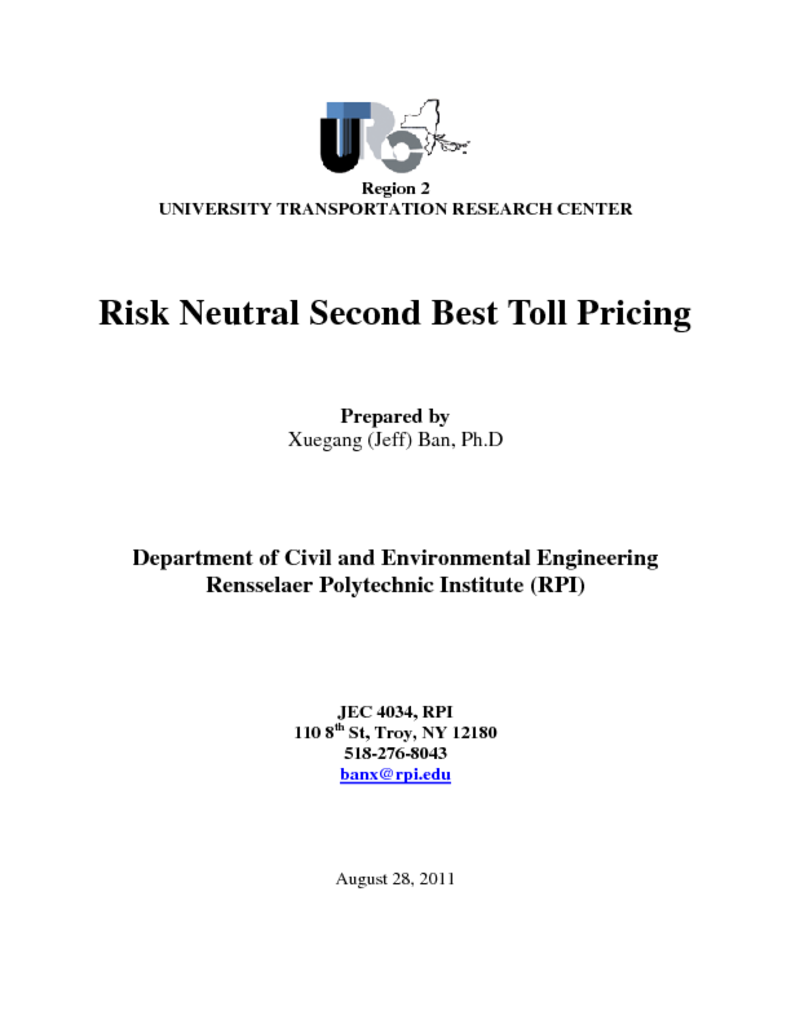<p>As traffic congestion builds up rapidly in recent years especially in urban areas like the New York City, Congestion Pricing (CP) has been proposed and widely implemented, which has now become 'the single most viable and sustainable approach to reducing traffic congestion (1).' One form of CP is called Second-Best Toll Pricing (SBTP), i.e. imposing appropriate tolls on selected locations (such as bridges or tunnels) of a transportation network so that congestion can be reduced. Research on SBTP is rich and still growing. Many researchers have modeled SBTP as bi-level problems. The upper level is to optimize certain objective from the transportation system's point of view (such as the total network VMT) and the lower level is a user equilibrium (UE) problem (either deterministic or stochastic) to account for the choice behavior of individual motorists (2). Most existing SBTP models assume that under a certain toll motorists have a unique response. Such a uniqueness assumption requires strong assumption on travel time or cost function of the traffic, which may not hold especially in metro areas if strong interactions exist among different links. The non-uniqueness of motorists response to pricing represents uncertainty in the SBTP design, which was not well recognized before. The question is then how tolls should be designed to account for this uncertainty. In this project, we aim to develop a risk-neutral scheme for SBTP. Such a scheme is designed to be optimal for the 'average' scenario, i.e. the average objective value is minimized as the response varies within certain range. The proposed study will expand our previous work on risk-averse SBTP scheme, which determines the toll optimal for the 'worst case' scenario (3), as well as traditional SBTP design schemes which are risk-prone as they are optimal for the 'best case' scenario (4). By considering all possible responses of motorists under a given toll, the proposed risk-neutral scheme is expected to be more reliable for toll pricing. The proposed research includes four major tasks: literature review, development of a stochastic program for the risk-averse SBTP scheme, algorithm development for solving the risk-neutral model, and case studies. In particular, the risk-neutral model and its associated solution method will be tested on small-scale illustrative examples, as well as relatively large and real-world SBTP test examples. Results and findings will be summarized as a paper and submitted to a peer-reviewed journal for publication upon completion of the project. The proposed risk-neutral scheme, together with the risk-averse approach we developed recently, addresses the fundamental question of SBTP design when drivers responses to road pricing are diversified, changing, and not unique. By developing more reliable tolls that can accommodate changing (and sometimes uncertain) driver behaviors, it is expected that the proposed research will make significant contributions to the state-of-the-practice congestion pricing design in New York City and the entire State, which is now an increasingly critical issue for the region and the nation. As the research focuses on long-range static traffic pattern changes, it aims to facilitate traffic management agency?s to devise more effective toll pricing plans to better manage transportation systems in response to motorists? varied behaviors. Therefore, the proposed study directly addresses the mission of UTRC, especially on planning, management, and responses to change.</p>




